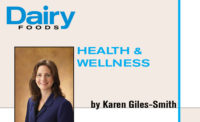Formulating
Designing dairy to the demographics
How can the dairy industry deliver what consumers desire? A new dawn of demographics reveals a plethora of possibilities.


|
|
These days, even a dairy product must multitask. If a food can deliver wellness, gratification/enjoyment, convenience/freedom and safety, then it has a good chance to succeed. Photo courtesy of Dairy Management Inc. |
Change can often be a deeply unsettling process that tests our faith and our resolve,” writes Robert Holden, author of the books “Shift Happens” and “Success Intelligence.” “Yet if we learn to handle change well, we can open ourselves up to new levels of creativity and success.”
Holden’s perspective applies to all aspects of life, including the dairy industry. And since there is not much that is not changing in the dairy industry, if managed well, the door to dairy product innovation is flung wide open!
A shift in consumer demographics is one of the major changes posing a challenge — and an opportunity — for the U.S. dairy industry. By 2020, 60% of the U.S. population will have chronic health conditions, 33% will be over age 55, 20% will be Hispanic, and the number of single households and male grocery shoppers will rise. As a result, consumers’ food and beverage choices will change. Some examples:
• As people age, their commitment to health increases.
• As people are exposed to foods from other cultures, their tastes alter.
• As households downsize, people prefer single-serve and easy-prep products.
To meet consumers’ complex and constantly changing needs, the Innovation Center for U.S. Dairy, Rosemont, Ill., predicts it will be necessary to “employ more multifaceted segmentation, micro-targeting and addressing of personalized needs (health and otherwise) in its product formulation, benefit package and messaging offerings,” according to its “The Future of Dairy” report.
To be engaging in the new era, a dairy product must multitask.
Although taste and price drive food and beverage choices more often than healthfulness, the Innovation Center has identified four major forces with potential to affect dairy sales: wellness, gratification/enjoyment, convenience/freedom and safety.
Let’s take a look at consumers’ wellness woes and ways the dairy industry can offer solutions.
In general, consumers’ top two health concerns are cardiovascular disease and weight. Running close behind are concerns about cancer, physical activity, sleep, diet, healthy aging, diabetes and mental health.
To further distinguish the details that drive consumers’ food and beverage choices, Cargill developed a “lifestages framework.” This framework also identifies well-being, including the desire to eat healthfully, as a major force — and one that is influenced by several factors including age and life stage (that is, parental status).
According to Cargill’s research, all generations want to be healthy but each generation has particular, and sometimes unexpected, health concerns. For instance, one of the top five health concerns of Gen Y (ages 18 to 30) is bone health/strength. Since osteoporosis isn’t usually on young folk’s radars, what gives?
“They may see bone health and strength as key to leading an active lifestyle and participating in sports,” explained Lakshmi Sitaram, senior marketing research analyst for Cargill.
Another interesting finding: The majority of Gen Y is open to getting nutrients through fortified foods — with a caveat. Over 50% of Gen Y believes fortified foods can help meet daily nutrient recommendations and they look for these products in stores. However, 50% also say they need more clinical proof regarding the bioavailability of added nutrients, according to “2011 Health and Wellness Trends Study” by the Natural Marketing Institute.
Lack of energy and stress top the list of health concerns of Gen X (ages 31 to 45), but they’re also concerned about heart disease and cancer, and many are interested in fortified and high-fiber foods and beverages. Gen X and Y are busy, so healthy products that are grab-and-go or require minimal preparation will resonate.
The older generations, Boomers (ages 46 to 64) and Matures (ages 65+), are mainly concerned with maintaining normal activity and staying mentally sharp. They gravitate toward “foods with benefits” (functional foods) to prevent or manage chronic conditions.
“For those over age 50, there is a spike in concerns about health,” noted Sitaram, “and people really start taking action.”
The good news is that dairy has what it takes to meet consumers’ health and wellness needs. Moderate evidence shows milk and milk products are linked to improved bone health, lower blood pressure, and reduced risk of cardiovascular disease and type 2 diabetes. And more is in store. Emerging science shows promise for dairy’s role in weight management, prevention of sarcopenia, enhanced athletic performance and improved cognitive health. Once well-established, the science will set the stage for promoting these health benefits — which can be packaged with other attributes consumers desire such as novel flavors and convenient, eco-friendly packaging.
But research takes time, and certain situations impede dairy product innovation.
“Even though the science is emerging regarding dairy and disease prevention, the labeling regulations are constricting,” said Cary Frye, vice president of regulatory and scientific affairs, International Dairy Foods Association, Washington, D.C.
Yes, there are several health claims that dairy can make, said Frye, but they must be phrased in “specific model claim language” that doesn’t happen to be market friendly; whereas structure/function claims are more understandable but perhaps not as influential. Frye assists IDFA’s dairy processor members with assessing the science and regulatory hurdles to determine what can be said on the label.
The federal standards of identity for dairy products are another hurdle. Modernization of the standards would allow processors more options when adding nutrients to dairy foods, said Frye.
“IDFA feels the food standards are outdated and plans to ask the FDA to modify them to allow for new technology, ingredients and nutritional modifications but still ensure that ‘characterizing ingredients’ remain.”
Frye believes the biggest wave of the future is protein.
“Right now, consumers are seeking protein for satiety, maintaining a healthy weight and muscle strength,” she said. “The technology is there to concentrate proteins through filtration or add milk or whey protein isolates.”
Although we can’t stop the waves of change, the dairy industry is learning to surf.
Looking for a reprint of this article?
From high-res PDFs to custom plaques, order your copy today!








